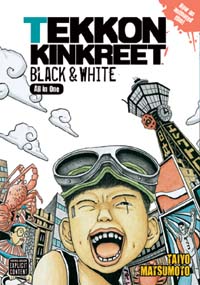By Taiyo Matsumoto

Originally released in Japan as three volumes, the English version of Tekkon Kinkreet (a play on the Japanese for “reinforced concrete”) has been a long time coming and brings all three together into one chunky omnibus edition.
Black and White are orphans, and brothers, who can fly. They live in Treasure Town and are members of team Cat, a street gang of no particular affiliation that runs roughshod over anyone and everyone that crosses them. Black is the older of the two, angry, violent and fearless while White is happy and naive to the point of autistic detachment. What they both do exceptionally well is beat the crap out of other people.
Into their world drops a group of mystery property developers, who intend to clean up Treasure Town for their own ends. Black decides he must protect the city he feels is his by any method – which to him means exacting terrible violence on the perpetrators – White is philosophical and more sanguine about the whole thing.
Pretty soon the brothers find themselves targeted by a tough trio of Mongol assassins who might just be their match. White ends up being taken into a witness protection program by the police, leaving Black alone and broken hearted, but Black’s worst enemy – and one he must learn to deal with – is the demon within himself.
Matsumoto’s Treasure Town is a mix of the less solubrious parts of any big city; it could be Osaka or Tokyo or it could be London, New York or Paris, and into that world he drops matching characters. There are no cutesy, big-eyed, small-mouthed kids here. Instead we get ruthless gangs, greedy mobsters and indifferent cops; warts and all characters with piggy eyes and horrific scars that are at once both grotesque and charming, but we also get Hippo’s on trains and rivers full of alligators adding surreal touches to the otherwise oppressive city.
Heavily influenced by the French comic artist Moebius, Tekkon looks like no other manga you’ve ever read and, in parts, could even be an American indy publication. The stark ink work uses lines that are thick and dark and the off-kilter camera angles often make it seem like the whole thing was drawn through a fish-eye lens. There is also real excitement in some of the action scenes – no doubt from Matsumoto’s love of sports – with a rare realism that makes the violence resonate, but despite this very stylised look, it has real Japanese sensibilities.
Manga purists may be disappointed that this edition has been flipped to read left to right, but what’s inside – the story and the artwork – is so good that I don’t feel it compromises anything. The translation by Lillian Olsen too is excellent. The dialogue never quite veers into cliche despite some near-misses, the ‘robust’ humour of the original is remarkably intact and the philosophical musings mostly ring true in the context of the setting.
It’s a weighty tome, taller, thicker and heavier than the average manga but that makes it less disposable, which for an important work such as this, is no bad thing; you get the sense that it will repay repeated readings from more mature readers by unveiling layer after layer of deeper meaning.
A long time coming, but well worth the wait.
Tekkon Kinkreet: Black and White is published by Viz Media and is available from Amazon, Blackwell and all good book stores.
